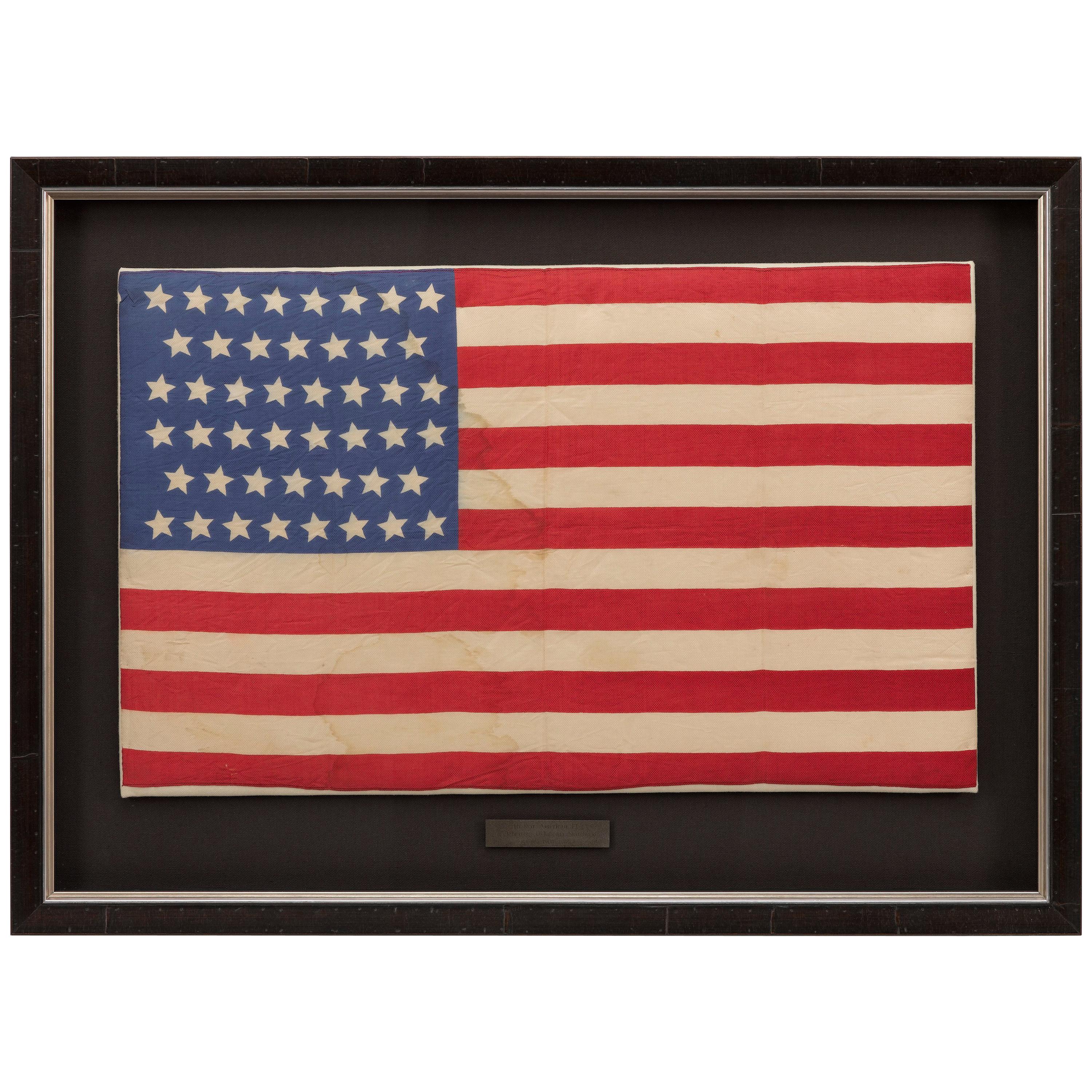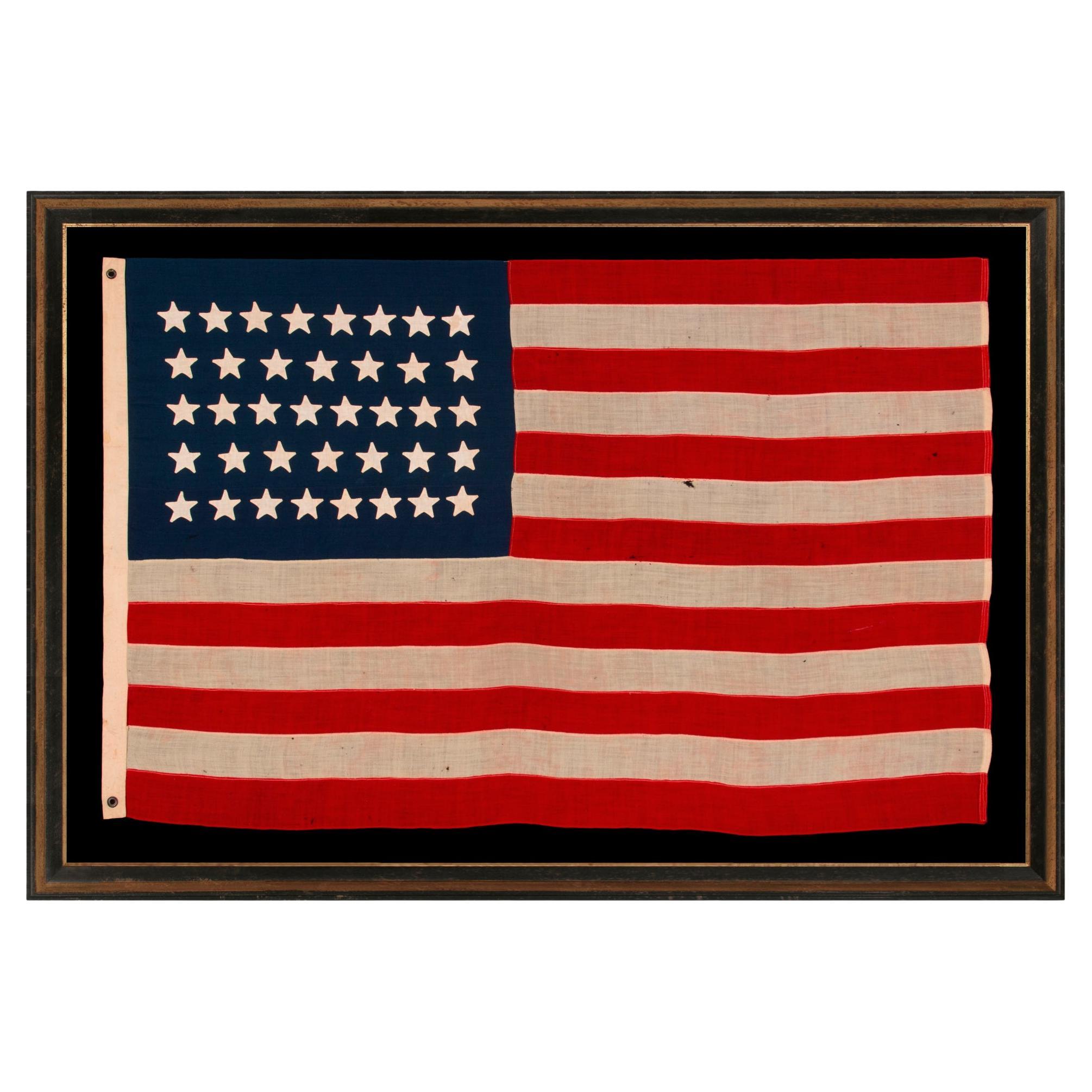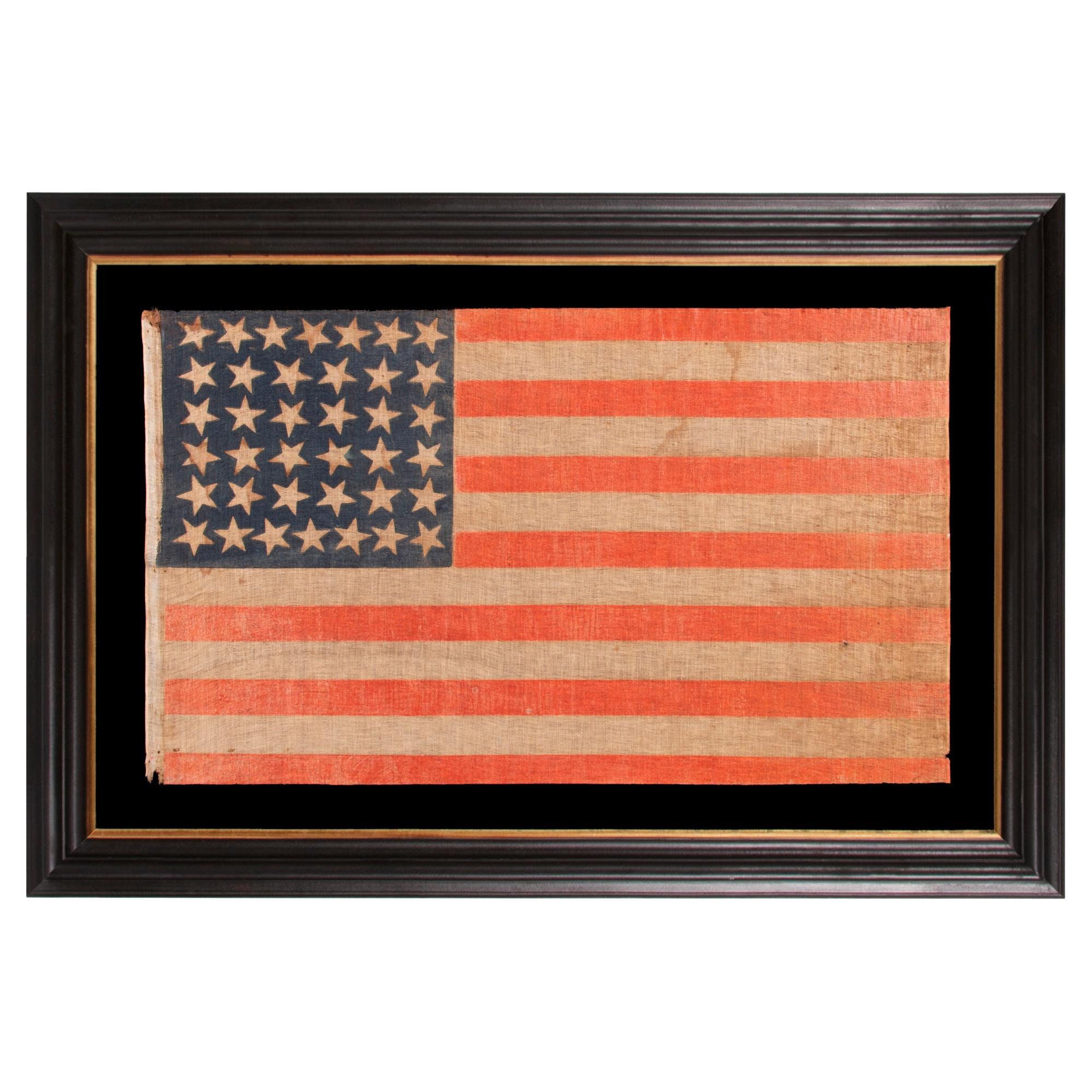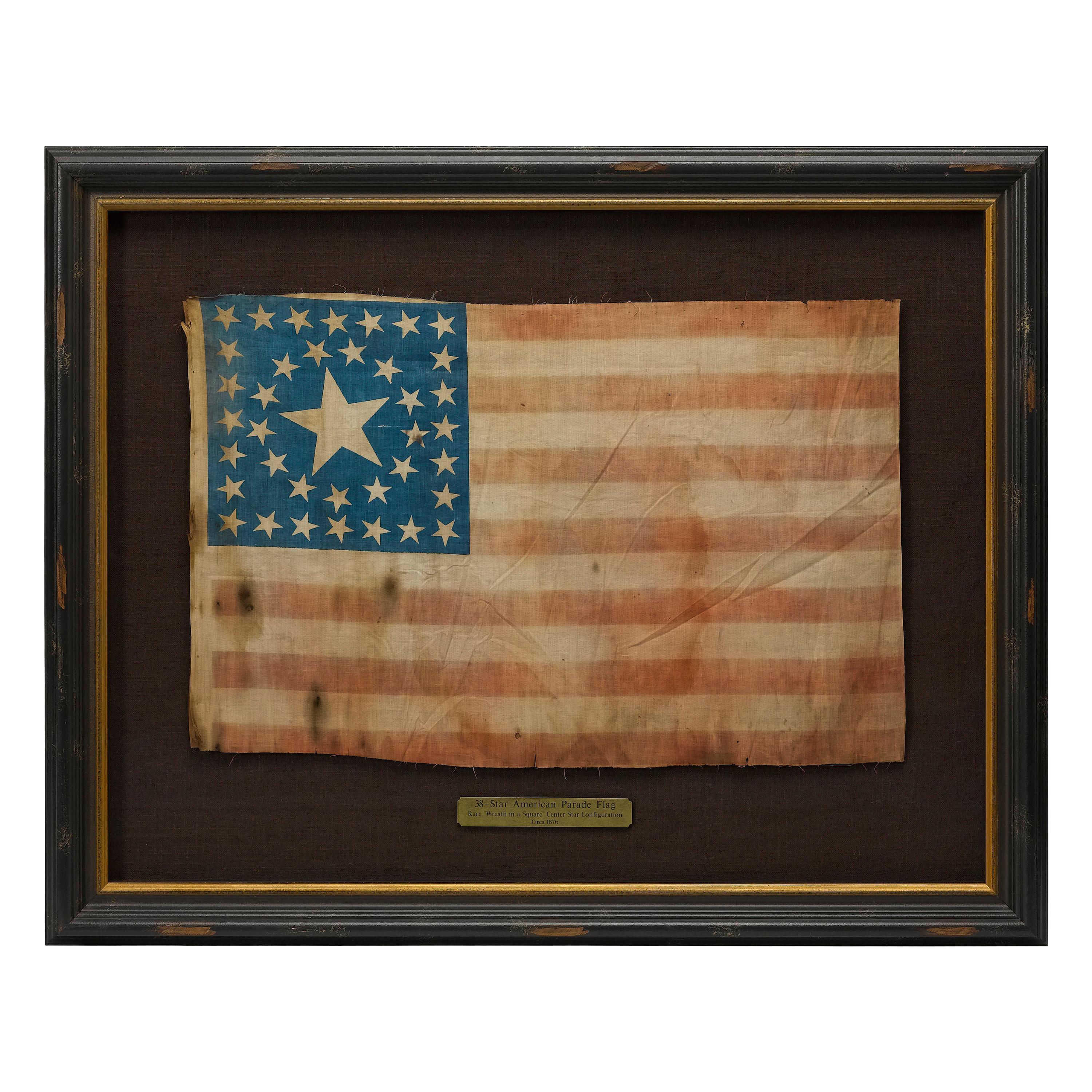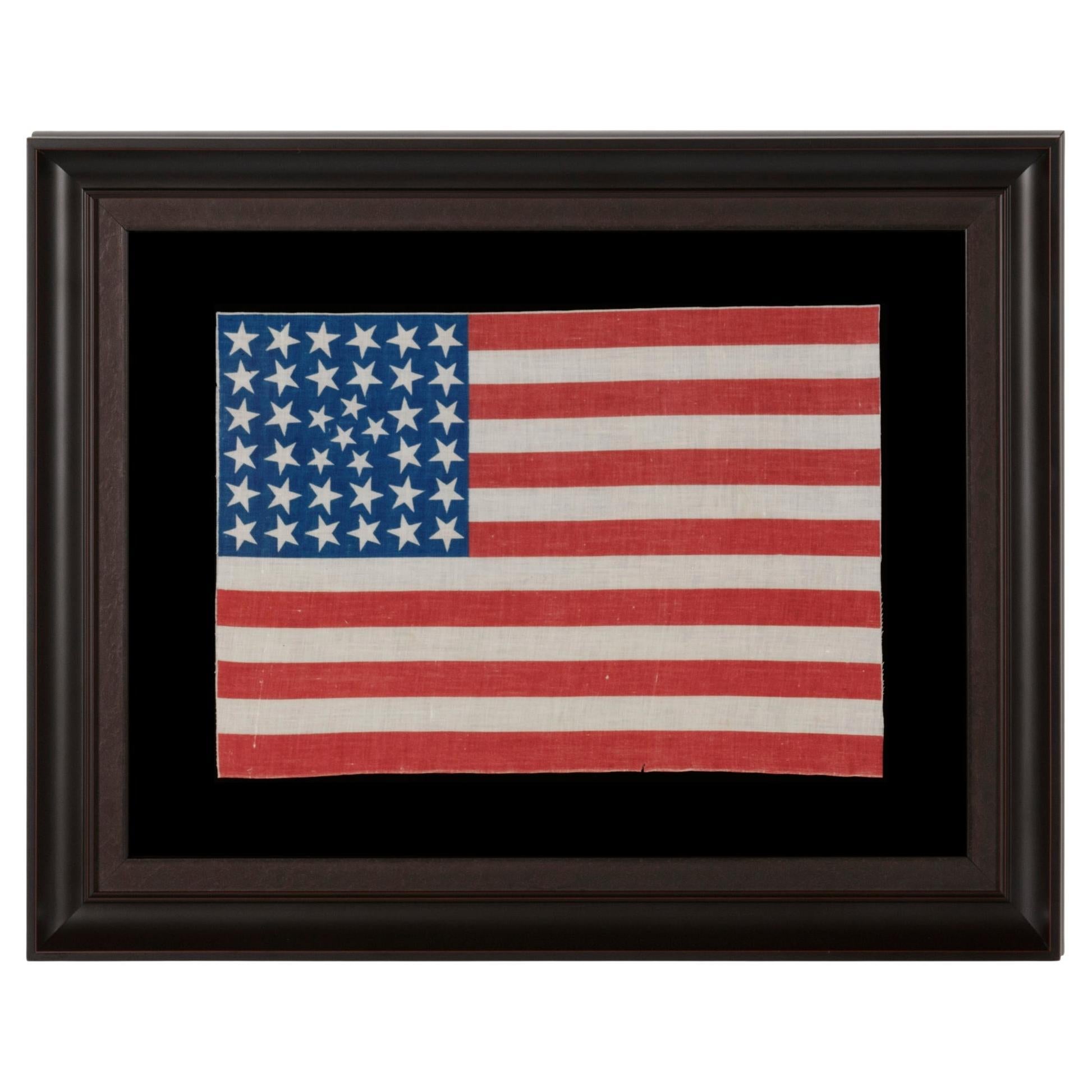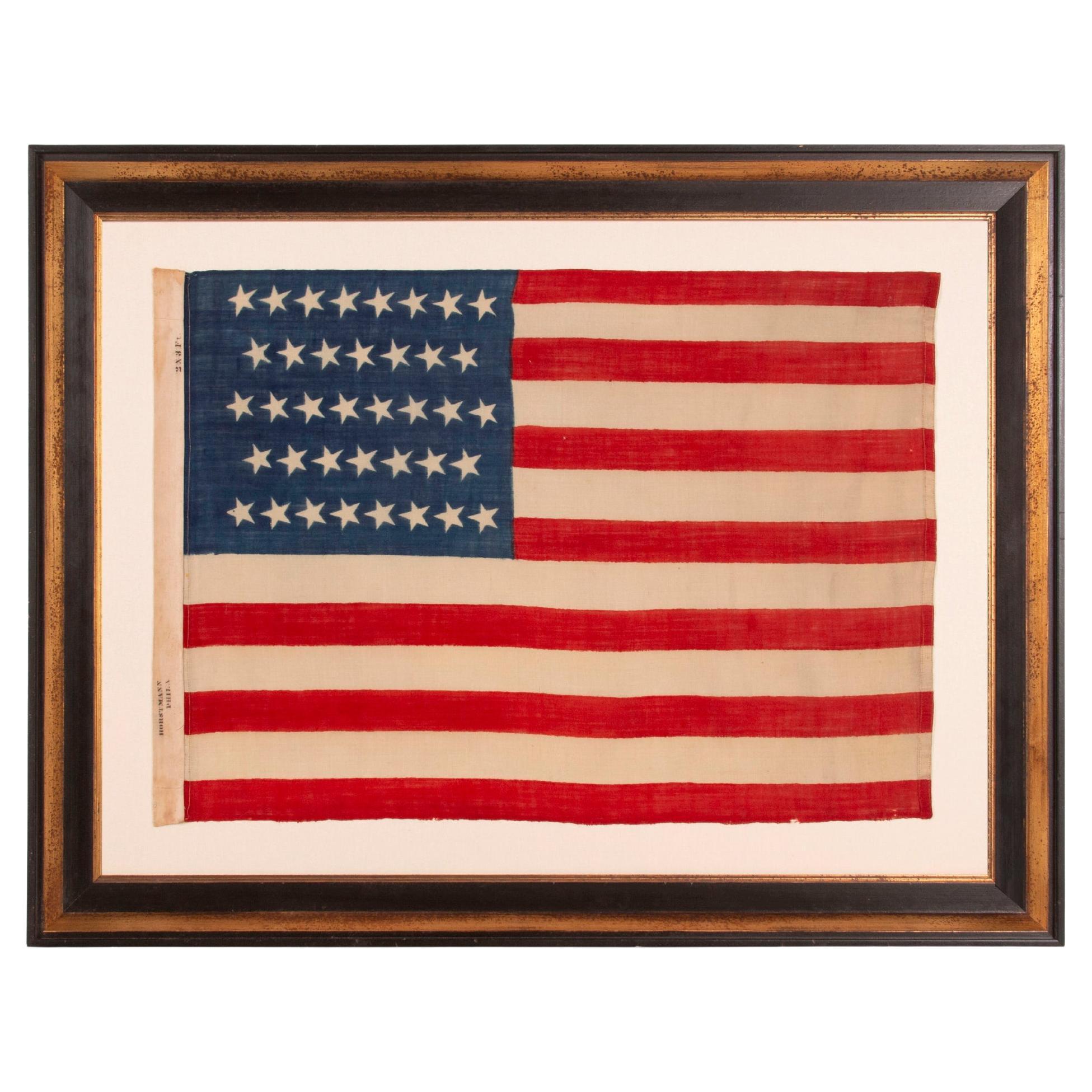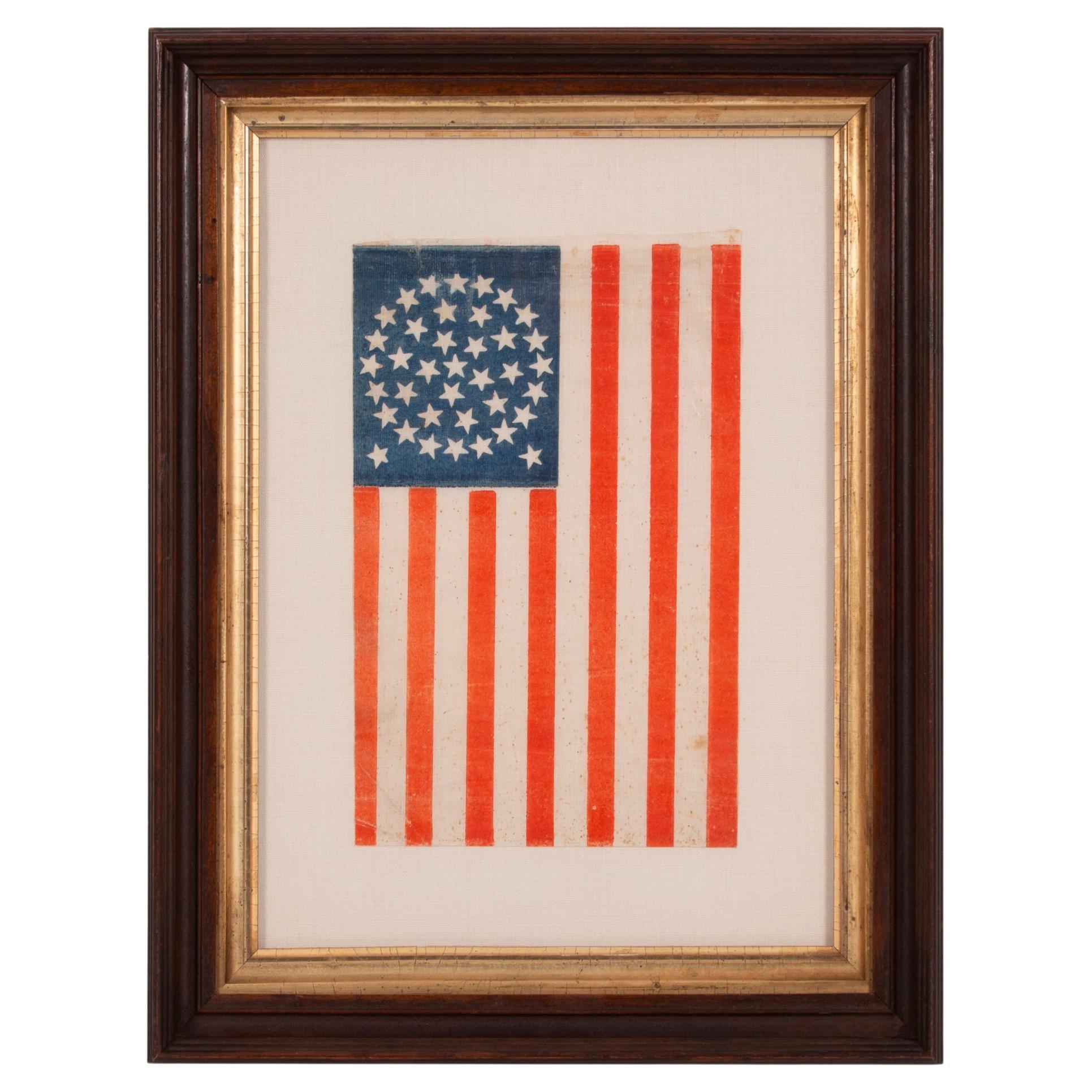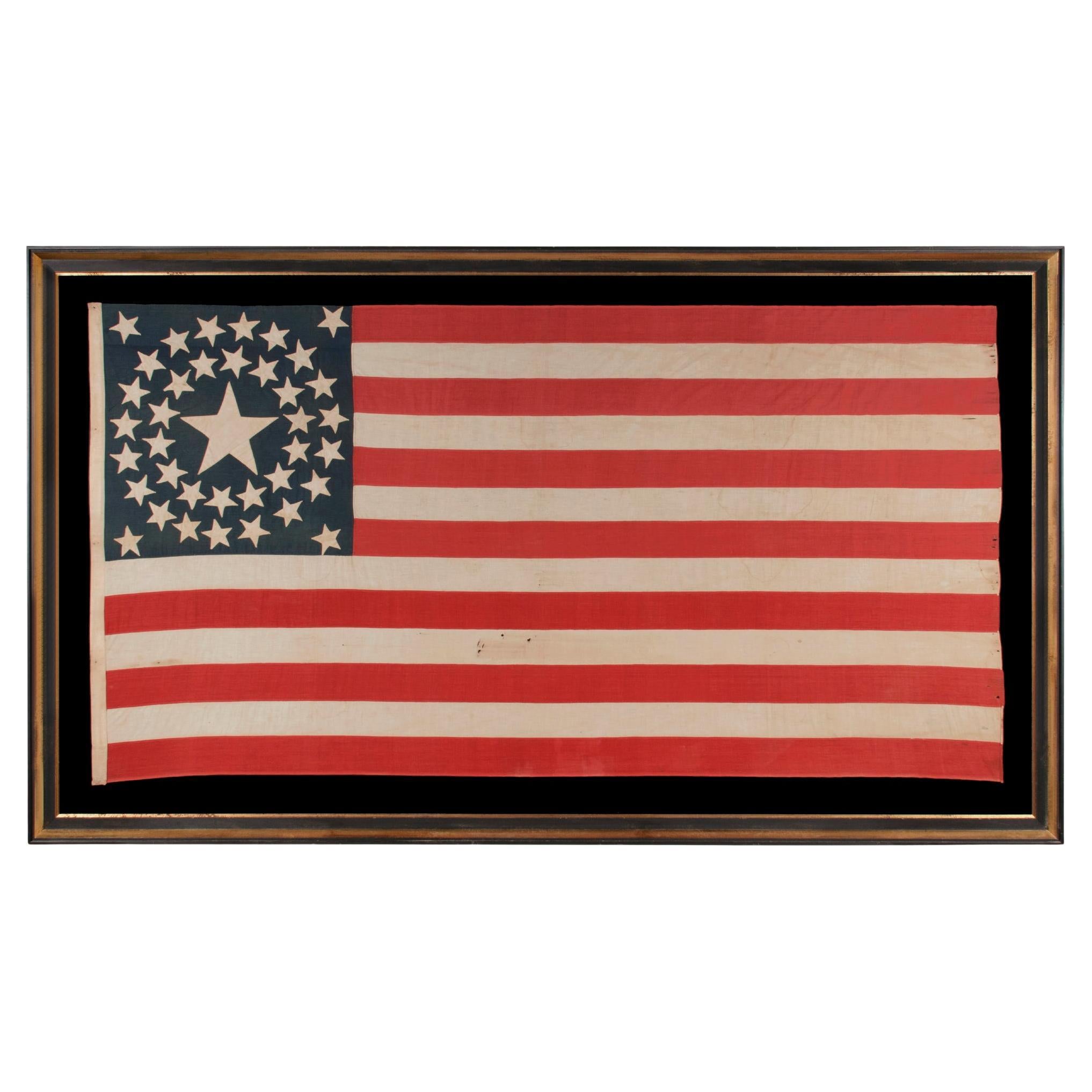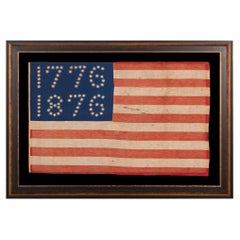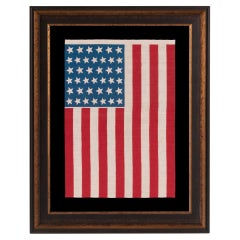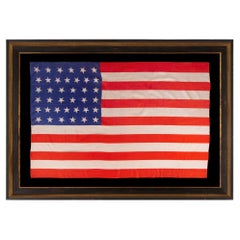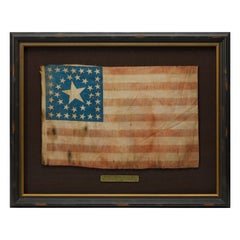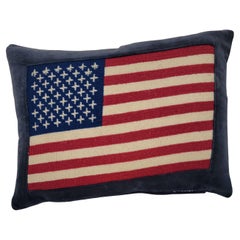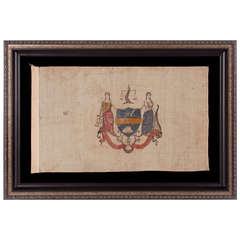
Early Flag of Philadelphia, Probably 1874-1876, Printed on Blended Fabric
View Similar Items
Want more images or videos?
Request additional images or videos from the seller
1 of 9
Early Flag of Philadelphia, Probably 1874-1876, Printed on Blended Fabric
About the Item
- Dimensions:Height: 35.5 in (90.17 cm)Width: 52 in (132.08 cm)
- Period:
- Date of Manufacture:1874-1876
- Condition:See Item Description.
- Seller Location:York County, PA
- Reference Number:Seller: ofj-8781stDibs: LU84971158166
About the Seller
5.0
Recognized Seller
These prestigious sellers are industry leaders and represent the highest echelon for item quality and design.
Established in 1991
1stDibs seller since 2008
61 sales on 1stDibs
Typical response time: 10 hours
More From This SellerView All
- 1776-1876 Centennial Celebration Flag, ca 1876Located in York County, PAAntique American Flag with 10-pointed stars that spell “1776 – 1876”, Made for the 100-Year Anniversary Of American Independence,one of the most graphic of all early examples. Man...Category
Antique 1870s American Political and Patriotic Memorabilia
MaterialsCotton
Price Upon Request - 39 Star Antique American Flag, Dakota Territories, ca 1876Located in York County, PA39 STARS IN TWO SIZES, ALTERNATING FROM ONE COLUMN TO THE NEXT, ON AN ANTIQUE AMERICAN PARADE FLAG DATING TO THE 1876 CENTENNIAL, NEVER AN OFFICIAL STAR COUNT,...Category
Antique 1870s American Political and Patriotic Memorabilia
MaterialsCotton
Price Upon Request - 38 Star Antique American Flag, Colorado Statehood, ca 1876-1889Located in York County, PA38 star antique American parade flag with scattered star orientation, made of silk, with generous scale and vivid colors, Colorado Statehood, 1876-1889 38 star American national p...Category
Antique Late 19th Century American Political and Patriotic Memorabilia
MaterialsSilk
Price Upon Request - 38 Star Antique American Flag, Colorado Statehood, ca 1876-1889Located in York County, PA38 STAR ANTIQUE AMERICAN FLAG WITH HAND-SEWN STARS IN AN 8-7-8-7-8 PATTERN OF JUSTIFIED ROWS, MADE IN THE PERIOD WHEN COLORADO WAS THE MOST RECENT STATE TO JOIN THE UNION, 1876-1889 ...Category
Antique Late 19th Century American Political and Patriotic Memorabilia
MaterialsWool
Price Upon Request - 38 Star American Flag, Stars in Notched Pattern, ca 1876-1889Located in York County, PA38 HAND-SEWN STARS IN A "NOTCHED" PATTERN, ON AN ANTIQUE AMERICAN FLAG WITH BEAUTIFUL WEAR FROM HAVING BEEN EXTENSIVELY FLOWN, MADE AT THE TIME WHEN COLORADO WAS THE MOST RECENT STATE TO JOIN THE UNION, 1876-1889 38 star Antique American flag, made during the period when Colorado was the most recent state to join the Union. The stars are arranged in what is known as a "notched" pattern, in which two spaces were left open along the hoist end, in the first and last rows, in anticipation that two more Western Territories would soon join the Union. The latter 19th century was a time of when much of the land in and about the Continental Divide was formalized into states, and there was continual speculation about which ones would be accepted next, and with what boundaries. The stars of the flag are made of cotton and are double-appliquéd (applied to both sides) with a lineal, treadle stitch. The canton and stripes of the flag are made of wool bunting that has been pieced with treadle stitching. The canton was constructed from five separate lengths of fabric, which is an unusual feature, though hardly unknown. To each of these a row of stars was sewn. This manner of construction is sometimes encountered and tends to be an early trait, at least when it occurs in flags of this scale and smaller. When encountered, it also seems to have been preferred in flags meant for maritime use. While the feature does not by any means guarantee this fact, it is a reasonable, educated guess, based upon my examination of many other examples. A flag with a 5-piece canton, such as this, would have been less likelihood to stretch, with increased structural integrity. The alternative is that this was simply an example made when there were at least five pieces of leftover fabric, of a reasonable size to made individual rows, and that what it actually demonstrates is the careful conservation of scarce resources. There is a sailcloth canvas binding along the hoist, with 3 brass grommets, evenly spaced. Perhaps the best feature of the flag is the evidence it displays of having been extensively flown, with the fly end whipped out from wind exposure. While many flags display damage from a combination of having been flown, exposure to the elements, various mishaps, and improper storage, very few exhibit wear such as this, which is both endearingly and visually attractive. This one shows its age beautifully, whipped out along the fly end, with losses that convey an element of movement, that most flags don’t capture in the state in which they survive. Colorado became the 38th state on August 1st, 1876. This was the year of our nation’s 100-year anniversary of independence. Per the Third Flag Act of 1818, stars were not officially added until the 4th of July following a state's addition. For this reason, 37 was the official star count for the American flag in 1876. Flag-making was a competitive venture, however, and few flag-makers would have been continuing to produce 37 star flags, when their competitors were making 38’s. It is for this reason that 38 and 13 stars (to represent the original 13 colonies...Category
Antique Late 19th Century American Political and Patriotic Memorabilia
MaterialsWool
Price Upon Request - 38 Star Antique American Parade Flag, Colorado Statehood, ca 1876-1889Located in York County, PA38 STAR ANTIQUE AMERICAN PARADE FLAG WITH JUSTIFIED ROWS OF 7-6-6-6-6-7 AND SCATTERED STAR ORIENTATION, MADE DURING THE PERIOD WHEN COLORADO WAS THE MOST RECENT STATE TO JOIN THE UNION, 1876-1889 38 star American national parade flag, printed on coarse cotton, possibly with flax content. One of the flag’s most interesting features is the wild sweep of the grain of the fabric, the warp and weft of which are anything but perpendicular. The stars are arranged in justified rows of 7-6-6-6-6-7. This results in a secondary pattern that I commonly call a “box-in-a-box-in-a-box”, because of the way in which the seemingly haphazard arrangement creates three consecutive squares. Note how the stars point in various directions on their vertical axis, which adds a nice element of folk quality to the overall design. Most parade flags in this star count have red stripes that lean heavily toward orange, with a vibrant, chromatic luster. This was common across printed flags produced between the 1850's and the 38 star period, phasing out in the last decade of the 19th century. Also note how the wear and patina contribute to an endearing presentation that displays its long-term use gracefully. Colorado became the 38th state on August 1st, 1876. This was the year of our nation’s 100-year anniversary of independence. Per the Third Flag Act of 1818, stars were not officially added until the 4th of July following a state's addition. For this reason, 37 was the official star count for the American flag in 1876. In the latter 19th century, it became common to add stars before the respective state(s) had even entered the Union. No one cared what was official, not even the military, where the matter of practicality with regard to flags always seems to have outweighed regulations. In the private sector, commercial flag-making was a competitive venture. Few flag-makers continued to produce 37 star flags when their competitors had jumped the star count to 38. It is for this reason that 38 and 13 stars (to represent the original 13 colonies) are more often seen at the Centennial International Exposition, the six-month long World’s Fair, held in Philadelphia, that served as the nucleus of the national celebration. Some makers of printed parade flags actually began to produce 39 star flags in 1876, in hopeful anticipation of the addition of two more Western Territories instead of one. The 39th state would not join the Union for another 13 years, however, when the Dakota Territory—thought to be coming as a single state—entered as two separate states on November 2nd, 1889. The 38 star flag generally fell out of production at that time, though it technically remained official until July 3rd, 1890. President Ulysses S. Grant was in office when the first 38 star flags would have appeared. The list of presidents that served during the period when the 38 star flag was official include Rutherford B. Hayes, James Garfield...Category
Antique Late 19th Century American Political and Patriotic Memorabilia
MaterialsCotton
Price Upon Request
You May Also Like
- 46-Star American Flag, Antique Printed on Silk, Early 20th CenturyLocated in Colorado Springs, COThis is an original 46-star American parade flag, printed on silk. Each star represents a state in the Union at the time. The official flag design would update every July 4th, to inc...Category
Antique Early 1900s American Political and Patriotic Memorabilia
MaterialsSilk
- 38-Star Antique American Flag with Unique Canton, circa 1876-1890Located in Colorado Springs, COThis is a striking 38-star American flag. The flag dates to 1876-1890, when Colorado (represented by the large star in the center of the flag’s canton) joined the Union as the 38th s...Category
Antique Late 19th Century American Political and Patriotic Memorabilia
MaterialsMuslin
- Early 20thc 48 Star Flag Hand Crochet PillowLocated in Los Angeles, CAThis fine hand crochet 48 star flag pillow is made with a blue velvet background or frame front and back.The insert is down & feather fill.Category
Early 20th Century American Adirondack Pillows and Throws
MaterialsWool
$556 Sale Price20% Off - Early 20th c. Monumental Belgian Flag c.1940-1950-FREE SHIPPINGLocated in San Francisco, CAABOUT An original monumental Belgian flag. CREATOR Unknown. DATE OF MANUFACTURE c.1940-1950. MATERIALS AND TECHNIQUES Wool, Metal. CONDI...Category
Early 20th Century Industrial Political and Patriotic Memorabilia
MaterialsBrass
$300 Sale Price34% Off - 46-Star American Flag Printed in Drum Star ConfigurationLocated in Colorado Springs, COThis is an original 46-Star American parade flag, celebrating Oklahoma statehood. Each star on the flag's canton represents a state in the Union at the time. The official flag design would update every July 4th, to include any new states added to the Union in the past year. Oklahoma, the 46th state, entered the Union on November 16, 1907. As such, this 46–star flag was the official flag of the United States from July 4, 1908, until July 4, 1912. The silk flag has a dark blue canton with 46 white printed stars. The stars are printed in an 7-8-8-8-8-7 row configuration, or “Drum design.” The flag design is completed with 13 alternating red and white stripes, each stripe representing one of the original thirteen colonies. The land that comprises Oklahoma today was added to the United States as part of the Louisiana Purchase of 1803. Throughout the 19th century, the U.S. government relocated Indian tribes from the southeastern United States to the area, and by 1900, over 30 Indian tribes had been moved to what was originally called the Indian Territories. At the same time, ranchers in Texas began to move into the area in search of new pasture lands. Although stipulations in the Indian Relocation Act agreed that the land would forever be Indian Territory, the promise of fertile farmland trumped the government’s promise of sovereignty. On April 22, 1889, they opened the land to settlement by homesteaders, creating a land run in which settlers, called “Boomers,” were allowed to cross the Texas or Arkansas border at a particular hour to claim homesteads. Settlers who illegally crossed the border earlier to stake prime land were called “sooners,” which eventually became the state’s nickname. Wagons and the Santa Fe railroad carried cartloads of men and women to blank town sites and building plots, creating ten thousand-people communities in a matter of days. The following year, the region was further divided into Indian Territory and Oklahoma Territory...Category
Vintage 1910s American Political and Patriotic Memorabilia
MaterialsSilk
- 41-Star Printed Flag Waver, Celebrating Montana Statehood, 1889Located in Colorado Springs, COPresented is a very rare, 41-star flag waver celebrating Montana statehood. The flag is printed on linen and dates to 1889. The dark blue canton is printed with forty one stars in nine rows of alternating counts of five and four stars. Thirteen red and white stripes complete the flag’s design. The history of Montana statehood is a long one. Numerous Native American tribes originally inhabited the Montana Territory. Meriwether Lewis, William Clark, and the members of their expedition were the first explorers to document a journey through Montana and the lands of the Louisiana Purchase. Soon, forts were established to facilitate regular fur trading with Native American tribes. Missionaries and trailblazers followed. The discovery of gold in the early 1860s sped the creation of the Montana Territory. As settlers and gold prospectors entered Montana in the 1860s and 1870s, conflicts with the Native Americans arose. Perhaps the most famous clash between Native Americans and the United States military occurred in Montana on June 25, 1876. On that day, Sioux and Cheyenne defeated Lieutenant Colonel George Armstrong Custer‘s 7th United States Cavalry regiment at the Battle of the Little Bighorn. A year later, Nez Percé Chief Joseph surrendered in the Bear Paw Mountains of Montana. Lured by copper in the 1880s, mining brought even more settlers to Montana. Rich grazing lands for cattle and sheep attracted other pioneers. Each of the states in America, with the exception of the original thirteen, Texas, and California, was first organized as a territory before achieving admittance to the Union as a state. Originating with the Ordinances of 1785 and 1787, the territorial system provided the expanding U.S. with a method to govern frontier areas until they gained sufficient population and economic maturity to qualify for statehood. Not surprisingly, residents of frontier territories usually demanded quick admission to statehood so they could gain full control of their local governments. Montana was a territory for 25 years – from the creation of Montana Territory in 1864 until the territory was admitted to statehood in 1889. On November 2, 1889, North and South Dakota were added to the Union as the 39th and 40th states, the first time in history that two states were admitted on the same day. Montana became the 41st state on November 8, predating Washington, the 42nd state, by only three days. Flag makers were not in the business of making out-of-date flags. As a result of these rapid changes in the number of states, only a small number of 41-star flags or commemorative items were ever produced, thereby making any 41-star flag exceedingly rare. CONDITION: Good condition. This flag is printed, with a hemmed headband and fly end in a running stitch...Category
Antique 1880s American Political and Patriotic Memorabilia
MaterialsLinen

